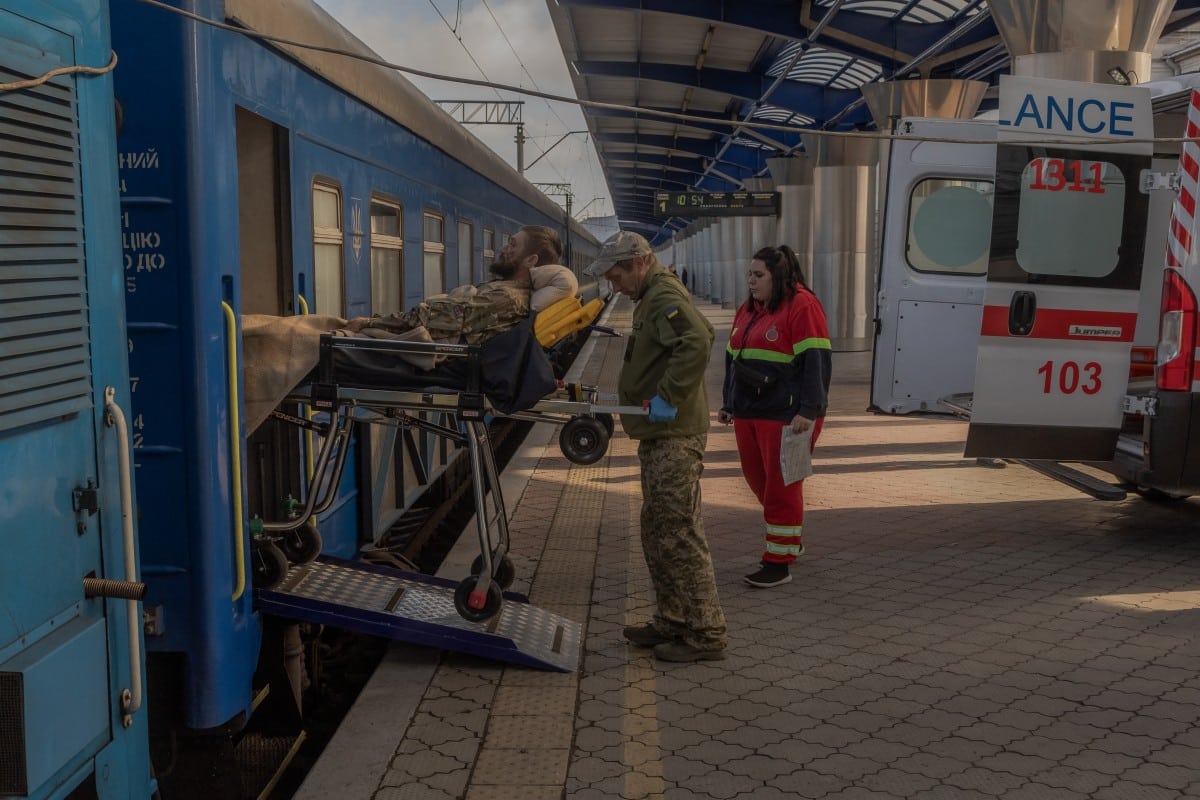
An injured Ukrainian soldier is transferred on a stretcher from ambulances to a military evacuation train transporting Ukrainian servicemen wounded in frontline areas to hospitals, in an undisclosed location, on October 18, 2024, amid the Russian invasion of Ukraine. Agence France-Presse
UKRAINE — It looks like an ordinary train waiting to depart an ordinary station, but through its fogged windows, a Ukrainian serviceman with face injuries lies stretched out on a gurney.
All of the other blue-and-yellow carriages of this train operated by the military are carrying wounded soldiers to hospitals away from the precarious front line.
Nearly three years after Russian forces invaded Ukraine, many medical facilities in war-battered eastern Ukraine have been damaged or destroyed, while those left untouched are overcrowded.
READ: ‘Our own front line’: Ukrainian surgeons see wave of wounded soldiers since counteroffensive began
For Oleksandr, the army doctor overseeing the evacuation, there are clear benefits to rail: many people can be moved at once and it is safer than transporting wounded soldiers by helicopter, given Russian superiority in Ukraine’s airspace.
But there are risks too.
“Our adversary in the war does not distinguish between what’s medical and military, so we take certain security measures,” the 46-year-old said.
AFP was recently granted rare media access to the train, whose points of departure and arrival are not being disclosed for security reasons.
‘Everything on the move’
Ambulances arrived at the station carrying dozens of wounded troops who were then hauled onto the train on stretchers and settled on beds with floral-patterned sheets.
READ: Zelensky says 31,000 Ukrainian soldiers killed since Russia invaded
Ukrainian flags and hand-drawn pictures by children annotated with patriotic messages lined the walls inside the train.
The carriages resemble a hospital until the train rolls away from the platform and gently rocks patients and staff — and everything else inside — as it crawls farther from the front.
“We do everything on the move, everything. Starting from the usual intravenous injections, ending with incubations,” said Viktorya, a nurse dressed in khaki and wearing blue medical gloves.
“We get dizzy afterwards,” the 25-year-old said, standing in front of a window, the sweeping Ukrainian landscape rolling by.
The journeys to and from the front, where Ukraine is coming under increasing pressure, have given Viktorya a painful insight into the cost of the conflict grinding through its third year.
“I understand the number of wounded now. It’s very hard to see it every day,” she said.
Kyiv — like Moscow — is tight-lipped about its soldier casualty count.
President Volodymyr Zelensky in February said the number of Ukrainian servicemen confirmed killed was around 31,000 — a figure observers say is likely an underestimate — but the number of missing and wounded has never been disclosed.
Worried about others
Most of those wounded were struck in artillery or drone attacks, staff explained, and many have had arms or legs amputated or were unconscious.
One carriage is designated for patients who have been in intensive care and doctors can even operate on patients in case of “force majeure,” doctor Oleksandr said.
Things can go wrong and mass bleeding — an unpredictable and rapid killer — is a major concern for staff.
“Staff are always near the patient,” Oleksandr explained, adding that they take turns using the toilet or eating.
Despite the logistical issues around caregiving on moving trains, the wounded soldiers’ preoccupations lie elsewhere.
“Their psychological state is not good,” Olena, a medical staff worker, told AFP.
“They’re not worried about losing a limb or whatever else. What depresses them is how their comrades are and how their family is,” Olena added.
‘A sigh of relief’
One Ukrainian serviceman on the train was being treated for a gunshot wound after being caught in a Russian ambush that also killed one of his fellow soldiers.
“Four of us left but not all of us returned,” the 28-year-old who identified himself as Murchyk said.
But he was already gauging when he might be able to make his way back to the front, where Ukraine’s outnumbered forces have been ceding ground to determined Russian advances.
Whether Murchyk can return to combat will be decided by a medical commission, but he said he was clear-eyed about his wish.
“I’d like to go back,” he told AFP.
The train evacuations in Ukraine began when the war did, in February 2022.
It revives a process used in World War II, with several refitted trains now taking wounded troops from the front.
When Oleksandr’s train arrives at its destination, ambulances are already waiting for the patients to be loaded off and taken onwards to hospital.
“It is of course very stressful and yes, you breathe a sigh of relief when you arrive and unload,” he said, “when you see that all the ambulances have left, when the platform is empty and the train is empty.”

